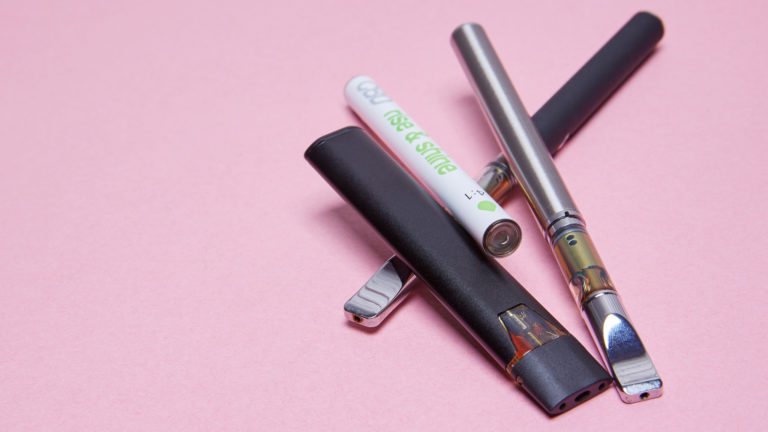Today, smoking and vaping are among the most common methods of consuming cannabis. Whether you're a seasoned cannabis consumer or brand new to the world of weed, it's important to understand the differences between smoking a joint and puffing on a vape pen, as they can distinctly influence both your high and your health.
Read on to learn more about the health, financial, and lifestyle considerations for vaping vs. smoking cannabis.
 Photo by: Photo by: Gina Coleman/Weedmaps
Photo by: Photo by: Gina Coleman/WeedmapsImage lightbox

What is smoking?
Puff, puff, pass! For as long as human beings have been enjoying cannabis, smoking has been among the most (if not the most) common methods of consumption. When you smoke cannabis flower, you inhale smoke from the combusted flower into your lungs and the cannabinoids therein quickly make their way into your bloodstream. Smoking cannabis immediately initiates a wide range of physical and psychological effects, depending on the strain's cannabinoid and terpene content. Effects generally last around two to three hours.
While smoking weed will undoubtedly create an intoxicated feeling or “high," combustion actually destroys a good portion of the strain's cannabinoid content. This means that valuable cannabinoids and terpenes are inevitably wasted.
Smoking continues to be widely popular because it is enjoyable, convenient, shareable, portable, and contributes to the overall sensory experience of cannabis. According to a study published in JAMA in 2019, 77% of medical cannabis patients reported smoking as their favorite way to consume cannabis.

Image lightbox

What is vaping?
Vaporizing, or vaping, has become a very popular alternative to smoking cannabis. A vape refers to a vaporizer or similar device that heats cannabis flower or a cannabis concentrate, transforming it into a vapor that can be inhaled.
Vaping heats cannabis without combusting it, meaning that when you inhale it, you're inhaling cannabinoid and terpene-rich vapor, as opposed to smoke. Both cannabis flower and concentrates can be vaped.
Vaporization is meant to occur just below the temperature of combustion. Despite the need for more research, vaping lab-tested, verified cannabis is typically accepted as a healthier and stronger alternative to smoking. Vaping is also recommended because it preserves the cannabis strain's flavors and activates precious cannabinoids, terpenes, and flavonoids that would otherwise burn off in combustion.
According to some studies and anecdotal evidence, vaping can produce a stronger high because of the higher concentration of potent cannabinoids as well as the entourage effect that occurs when you consume a wider array of cannabinoids. A study conducted at Johns Hopkins and published in JAMA Network Open in 2018 suggests that vaping cannabis delivers stronger psychoactive effects to infrequent consumers more quickly than smoking it.
And, while everybody experiences cannabis differently, anecdotal evidence suggests that the psychoactive effects of vaping do feel somewhat different than the effects of smoking. Vaping cannabis may allow for a more controlled method of inhalation compared to smoking, which can help contribute to a cleaner-feeling high. Consumers can adjust the temperature at which the flower or concentrate is inhaled, which can impact the potential therapeutic effects. Since essential compounds don't burn away as they do with combustion, consumers are able to taste the nuanced flavor of the strain they're inhaling, which may elevate the experience.
How does smoking impact my health?
It is important to be mindful of the health risks of combustion if you choose to smoke cannabis. Inhaling smoke of any kind is harmful to the lungs over time.
Smoking releases tar and carcinogens into the lungs and over the long term, smoking is associated with pulmonary inflammation, chronic respiratory illnesses, and other health concerns.
Studies indicate that cannabis smoke contains many of the same carcinogens and chemicals as tobacco smoke. However, cannabis and tobacco smoke are not equally carcinogenic. Despite the health risks cannabis smoke does impose, an established causal link between inhaling it and developing cancer has not yet been found.
Additionally, there are health risks that come along with smoking both paper and the tobacco products some cannabis consumers use to roll joints or spliffs with, including exposure to heavy metals and pesticides. When you burn rolling papers, hemp leaves, and lighter fluid chemicals, it releases harmful compounds as well. Glass pipes and bongs can help negate these issues, but if you choose to smoke using glass pieces, be sure to clean your glass regularly to avoid tar buildup and other issues.
 Photo by: Gina Coleman/Weedmaps
Photo by: Gina Coleman/WeedmapsImage lightbox

Is vaping healthier than smoking?
Unfortunately, the answer is not as simple as one might think. It is important to understand that while the science is promising, vaping is not completely free of risk.
When cannabis is vaporized, it is generally accepted as being easier on the lungs. Research suggests that those who vape cannabis experience decreased respiratory symptoms compared to those who smoke, even when the amount of cannabis consumed increases. A study conducted by NORML and the Multidisciplinary Association for Psychedelic Studies in 2001 also suggests that vaping may suppress cancer-causing compounds that would otherwise be produced by cannabis smoke.
According to cannabis medicine expert Dr. Ethan Russo, vaping dried cannabis flower appears to be associated with significantly fewer health risks when compared to smoking. Vaping doesn't produce toxic secondhand smoke like smoking does, either.
While vaping dried cannabis flower appears healthier than smoking, that doesn't mean all vaping is harmless. Some vape products contain thinning agents, flavoring agents, and other additives, which, when broken down, can become carcinogenic. They can also expose consumers to toxic metals and ultrafine particles that can irritate the lungs. Terpenes added to concentrates are also a potential concern.
It is important to note that the 2019 vaping crisis was a result of illicit and often tainted THC cartridges being sold to unsuspecting consumers. Illicit THC cartridges are strongly correlated with a type of lung disease referred to as EVALI, according to the CDC, likely due to the cutting agent vitamin E acetate.
To decrease the risk of vaping harmful additives, it's imperative to purchase products from reputable sources that provide product testing data. Avoid purchasing illicit vape products and refrain from altering existing ones. Be mindful that purchasing vape products from a licensed dispensary is the safest option, but is not devoid of risk.
The truth is, the science behind vaping cannabis vs. smoking it remains unknown and often misrepresented for many people. More research is needed to uncover the long-term health risks of both.
Vaping vs. smoking: Lifestyle considerations
Smoking weed can be done solo or shared as a meaningful way to socialize. Often, preparing the weed for ingestion is part of the fun, ritualistic, and social aspects of smoking it.
Vaping, on the other hand, provides a more discreet experience than smoking, as it is easy to conceal and doesn't smell in the same way burning flower does. Cannabis smoke produces a distinctive odor that lingers.
Consumers have the option to vape both dried cannabis flower and cannabis concentrates, utilizing a wide range of vaporizers. Devices from handheld to tabletop, packable to disposable, e-cigarettes to volcanoes, and more offer unparalleled versatility and convenience. To vape cannabis, flower or oil is typically packed or pre-filled into a small chamber or cartridge, which is then heated using a battery and the vapor inhaled via a mouthpiece. To smoke cannabis, you typically grind the dried flower and pack it into the bowl of a pipe, bong, or bubbler before lighting it and inhaling the smoke through the mouthpiece.
Both vaping and smoking offer a range of approaches and price points to fit your lifestyle.
Bottom line
So, when it comes down to vaping vs. cannabis, is one better than the other?
At the end of the day, better is subjective. Both vaping and smoking carry risks as well as unique potential benefits and experiences. Whether you are puff, puff, passing the joint or the vape is ultimately up to your priorities and preferences.
Remember that with any consumption method, it is important to start low and go slow to find what dosage works best for you.




